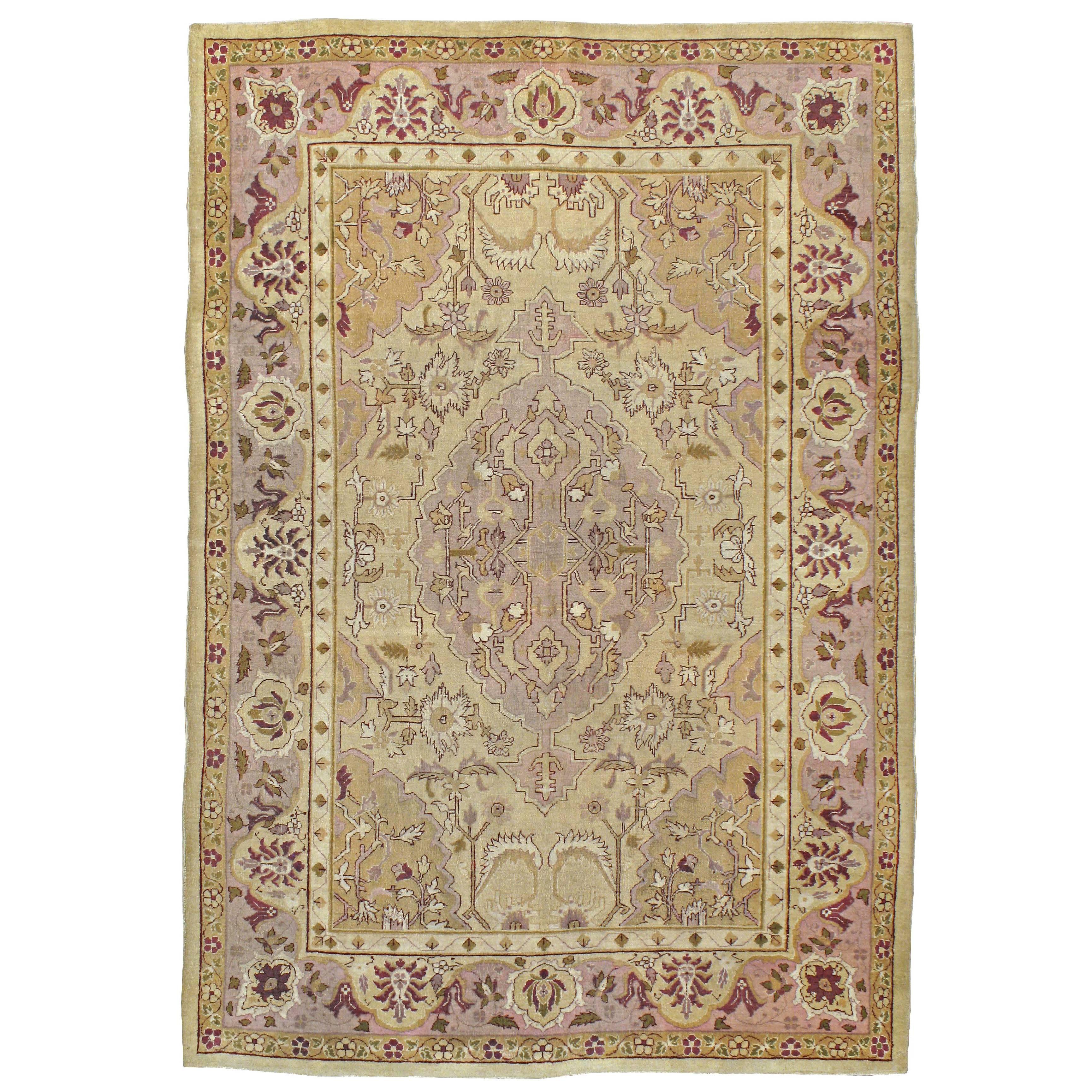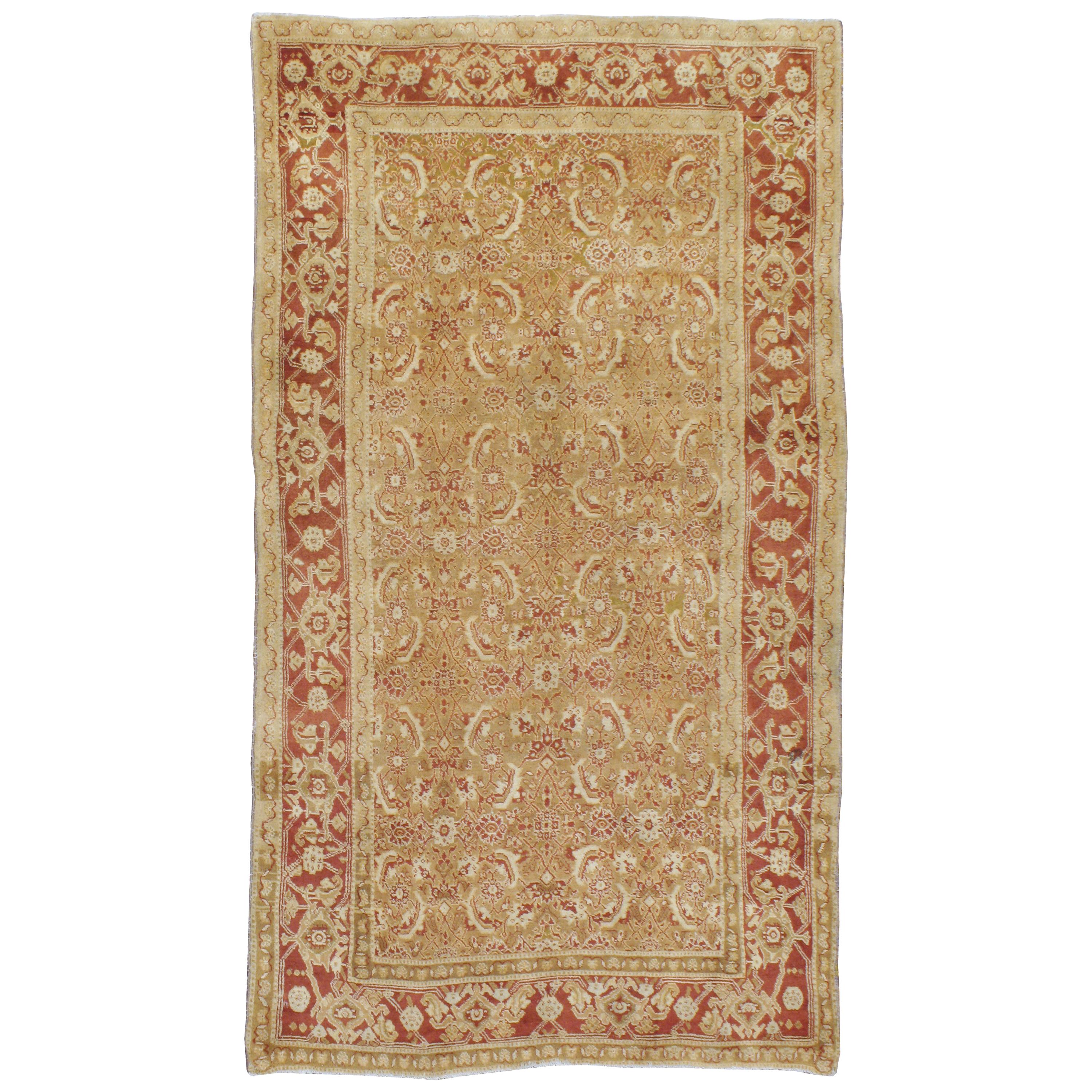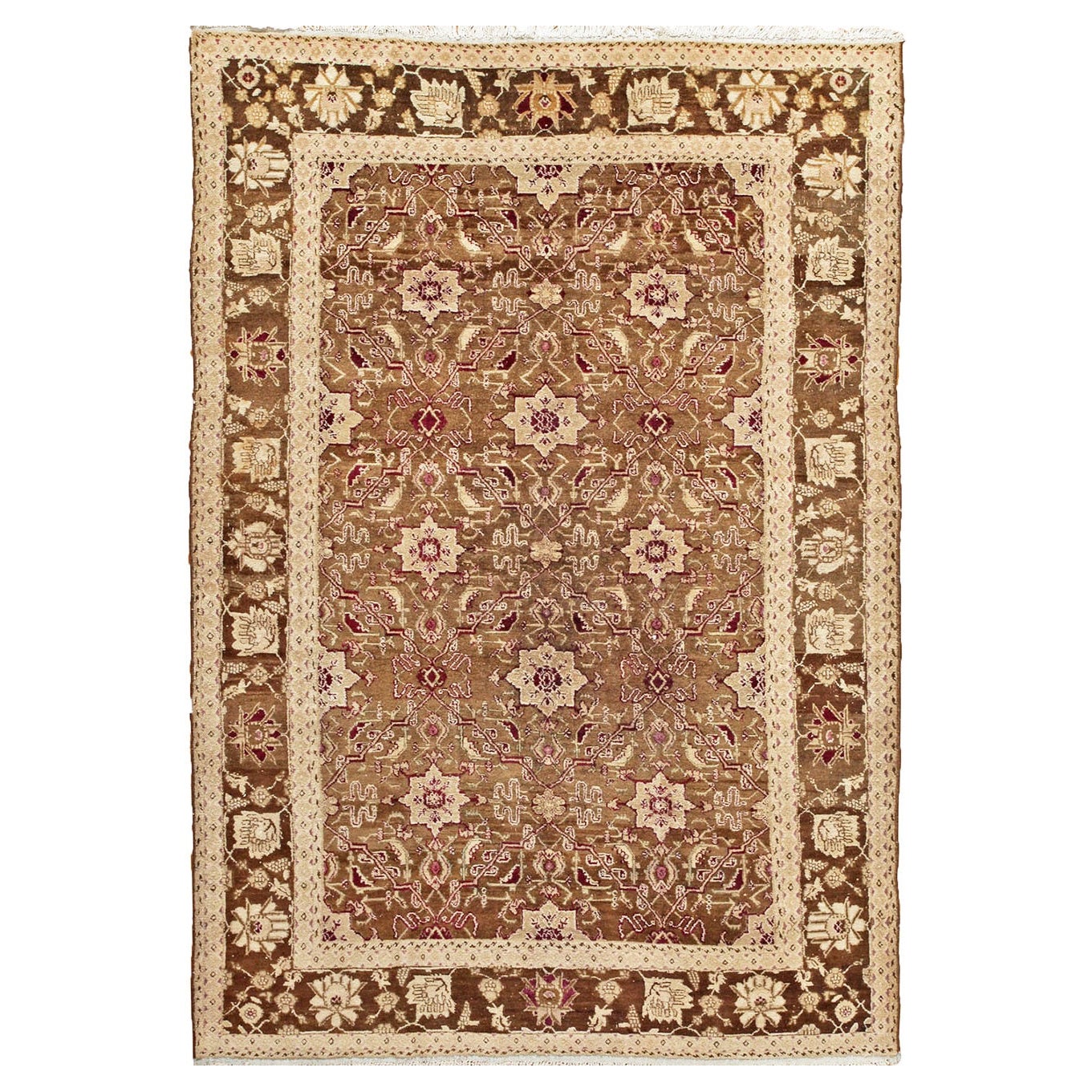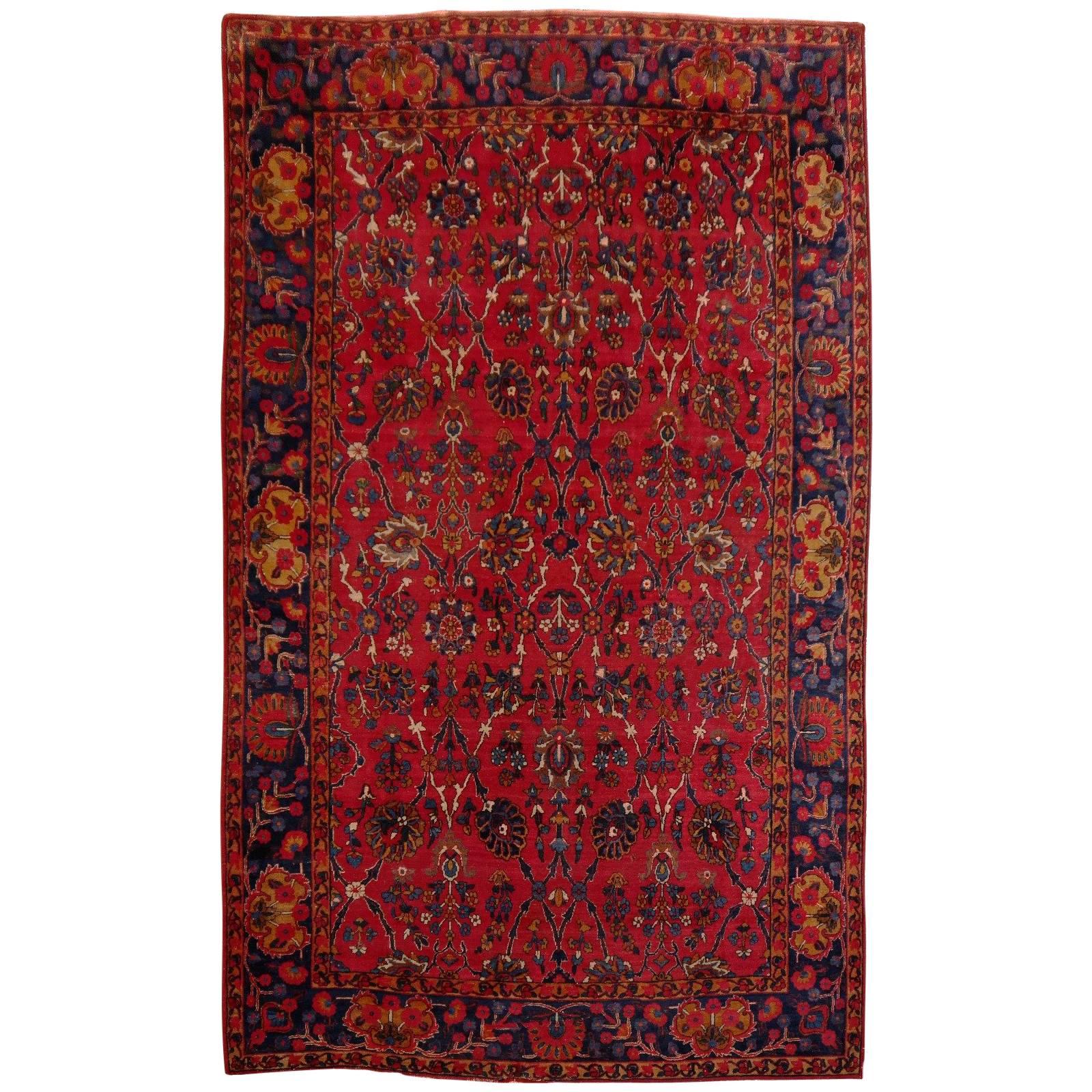Items Similar to Antique Agra Area Rug
Want more images or videos?
Request additional images or videos from the seller
1 of 5
Antique Agra Area Rug
About the Item
The Indian city of Agra, home of the infamous the Taj Mahal, has an extensive and notable tradition of carpet weaving. Agra was a major production center for the best of the classical Mughal carpets. The city was likewise one of the three prominent carpet production centers in India. Even though the weaving industry in that area was limited, its workshops produced elegant antique carpets that have been praised for their thorough originality and workmanship. Semi-antique, as well as antique carpets from Agra, are greatly sought after, earning their rank among some of the finest decorative Indian carpets.
Agra rugs made in the early 20th century were usually of a more marketable nature rather than the superb quality of their ancestral counterparts. The carpets produced during the 19th century are universally valued by both interior designers and collectors. In addition, Agra rugs are distinct and highly acclaimed works of art whose delicate palette of color and fanciful drawings are quite unique among decorative antique carpets. Overall, most 19th century Agra productions will also be considered as superb art investments.
Today, Agra rugs are one of the, if not the most highly sought after rugs of 19th century India. In terms of production, they were extremely well made, possessing a satisfying amount of weight and durability. Overall, they're viewed as the best Indian rug from the post-Mughal era.
Agra carpets combine the grandeur and grace of the well-known Persian antique carpet designs with their own original themes. There can be observed designs of spiralling vines, often combined with small organisms such as birds, elephants, and even people. Developed for the Mughal emperors, a popular Agra carpet design consists of rows of flowers in vases. In turn, this design was embraced by the Persians and can be found in floral Persian carpets. The whole artistic “cross pollination” between these two places, Agra and Persia, carried on until the end of the 19th century. Weavers of Agra were masters at vegetable dyeing and eventually created their own unique palette of color. Profusion of gold combined with soft mid-tone blues is often flaunted. The weavers furthermore used a range of soft rust-reds, pinks, and a quite appealing lavender tone. These combinations of color give many Agra rugs a light, ethereal appearance which is beautiful and stunning in any home.
- Dimensions:Width: 61.2 in (155.45 cm)Length: 85.2 in (216.41 cm)
- Style:Agra (In the Style Of)
- Materials and Techniques:
- Place of Origin:
- Period:
- Date of Manufacture:1900
- Condition:
- Seller Location:New York, NY
- Reference Number:

About the Seller
4.6
Vetted Seller
These experienced sellers undergo a comprehensive evaluation by our team of in-house experts.
Established in 1916
1stDibs seller since 2019
93 sales on 1stDibs
Typical response time: 6 hours
- ShippingRetrieving quote...Ships From: New York, NY
- Return PolicyA return for this item may be initiated within 7 days of delivery.
More From This SellerView All
- Antique Agra RugLocated in New York, NYAntique Agra rug 4' x 6'9''. The northern city of Agra was once the capital of the Mughal Empire and has been weaving high quality rugs in all format...Category
Vintage 1910s Indian Rugs
MaterialsWool, Cotton
- Antique Indian AgraLocated in New York, NYAntique Indian AgraCategory
Antique 1890s Indian Indian Rugs
MaterialsWool, Cotton
- Pak Tabriz Design Rug 10'0'' x 14'0''Located in New York, NYA Pakistani rug (Pak Persian Rug or Pakistani carpet) is a type of handmade floor-covering textile traditionally made in Pakistan. Pak Persian Persian inspired curvilinear and/or floral designs, usually styled from old Kashan...Category
20th Century Pakistani Indian Rugs
MaterialsWool, Cotton
- Pakestan Rug Tabriz Design, Hand KnottedLocated in New York, NYPakistan rug Tabriz design, hand knotted Design: Tabriz Color: Black border, beige The art of weaving developed in the region comprising Pakistan at a time when few other civilizations employed it. Excavations at Moenjodaro and Harappa, ancient cities of the Indus valley civilization, have established that the inhabitants used spindles and spun a wide variety of weaving materials. Some historians consider that the Indus Valley civilization first developed the use of woven textiles. Carpet weaving may have been introduced into the area of present-day Pakistan as far back as the eleventh century with the coming of the first Muslim conquerors, the Afghan Ghaznavids and the Ghaurids. It can with more certainty be traced to the beginning of the Mughal Dynasty in the early 16th century, when the last successor of Timur, Babur, extended his rule from Kabul, Afghanistan to Dhaka, Bangladesh and founded the Mughal Empire. Under the patronage of the Mughals, local craftsmen adopted Persian techniques and designs. Carpets woven in the Punjab at that time (often called Lahore carpets today) made use of motifs and decorative styles found in Mughal architecture. Photograph of carpet weavers in Karachi Jail, 1873 During the Mughal period, the carpets made on the South Asia became so famous that demand for them spread abroad. These carpets boasted distinctive designs and high knot densities. Carpets made for the Mughal emperors, including Jahangir and Shah Jahan, were of the finest quality. Under Shah Jahan's reign, Mughal carpet-weaving took on a new aesthetic and entered its classical phase. The carpets woven in Lahore were the first to reach European markets, including England, as far back as 17th century. During the British colonial era, prison weaving was established in district and female jails in cities such as Lahore and Karachi. Carpet-weaving outside of jails was revived after the independence when Pakistan's carpet-weaving industry flourished.[1] At present, hand knotted carpets are made by Afghan refugees residing in Pakistan, making carpets and one of the country's leading export products. Hand knotted rug manufacture is Pakistan's second-largest cottage and small industry. The craftsmen have the capacity to produce any type of carpet using all the popular motifs of guls, medallions, paisleys (botehs), traceries, and geometric designs in various combinations. Pak Persian Persian inspired curvilinear and/or floral designs, usually styled from old Kashan...Category
2010s Pakistani Tabriz Indian Rugs
MaterialsWool
- Fine Indo Tabriz Persian Design Indian Rug, Hand KnottedLocated in New York, NYFine Indo Tabriz Persian design Indian rug, hand knotted Design: Floral Carpets are an integral part of Indian craft traditions. The tradition of carpet weaving in India is c...Category
2010s Indian Tabriz Indian Rugs
MaterialsWool
- Antique Persian Heriz Area RugLocated in New York, NYHeriz rugs are one of the most famous rugs from Iran, because of their very unique and distinguishable style. Heriz is a city located in northwestern Iran, near the city of Tabriz, w...Category
Early 20th Century Persian Heriz Serapi Persian Rugs
MaterialsCotton, Wool
You May Also Like
- Antique Indian Agra RugLocated in New York, NYAn antique Indian Agra carpet from the first quarter of the 20th century.Category
Early 20th Century Indian Agra Indian Rugs
MaterialsWool
- Antique Indian Agra RugLocated in New York, NYAn antique Indian Agra rug from the early 20th century utilizing a large-scale rendition of the popular Persian "Herati" pattern and "Turtle Palmette" border often found in Persian M...Category
Early 20th Century Indian Rustic Indian Rugs
MaterialsWool
- Antique Indian Agra Rug. Size: 5 ft 9 in x 8 ft 5 inLocated in New York, NYAntique Indian Agra Rug, Origin: India, Circa: Turn of the 20th Century. Size: 5 ft 9 in x 8 ft 5 in (1.75 m x 2.57 m)Category
Early 20th Century Indian Agra Indian Rugs
MaterialsWool
- Antique Indian Agra Rug hand knotted red blue goldLocated in Lohr, Bavaria, DEBeautiful antique Indian rug from Agra. Good condition with some low pile and old restorations. This stunning hand knotted rug originates in ancient Agra, the city of the Taj Mahal....Category
Early 20th Century Indian Agra Indian Rugs
MaterialsWool
- Oversized Antique Indian Agra Rug, Hotel Lobby Size CarpetLocated in Dallas, TX71600 Oversized Antique Indian Agra Rug, 16'00 x 28'00. Emanating regal charm with incredible detail and texture, this oversized antique Indian Agra rug is a captivating vision of w...Category
Antique Late 19th Century Indian Agra Indian Rugs
MaterialsWool
- 1880s Oversized Antique Indian Agra Rug, Hotel Lobby Size CarpetLocated in Dallas, TX70247 Antique Indian Agra Room Size Rug with Art Deco Style. Cleverly composed and distinctively well-balanced, this antique Indian Agra displays an exceptional all-over geometric pa...Category
Antique Late 19th Century British Indian Ocean Territory Agra Indian Rugs
MaterialsWool
Recently Viewed
View AllMore Ways To Browse
Used Furniture In The Area
Antique Carpet Designs
Delicate Antique
Cotton Area Rug
Area Rugs Cotton
Area Rug Weaving
Midcentury Area Rugs
Mid Century Area Rug
Mid Century Area Rugs
Area Rugs In Brown Color
Antique Area Rug
Antique Area Rugs
Antique Area Carpets
Antique Wool Area Rugs
Designer Area Rug
Collector Rugs
19th Century Area Rugs
Most Sought After Antiques





